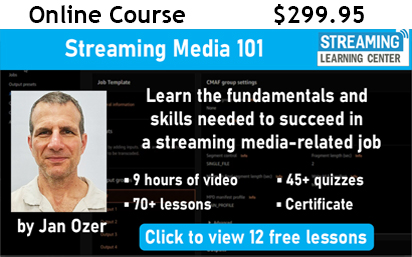These are the most popular encoding-related articles on the Streaming Learning Center over 2019-2020. I hope you find this list of general encoding resources useful.
Lesson of the Week: CMAF Proof of Concept – The Common Media Application Format (CMAF) is supposed to be the Holy Grail of streaming; one set of files that you can deliver to multiple output points. How well does it work today? This 3:47 video shows you.
Everything You Ever Wanted to Know About IDR Frames but Were Afraid to Ask – Depending upon your encoding tool, you may have access to a checkbox or number box that controls something called IDR frames. What are these creatures and what is their significance? More importantly, what’s the optimal setting?
Saving on Encoding and Streaming: Deploy Capped CRF – Capped CRF encoding is a single-pass encoding method that can save encoding costs compared to two-pass VBR. Capped CRF is also a simple per-title encoding method that can reduce your bandwidth costs and improve viewer QoE. Capped CRF is a credible technique currently used by JWPlayer in the company’s online video platform for both H.264 and VP9.
Streaming 101: The Basics – Codecs, Bandwidth, Data Rate, and Resolution – The ability to produce streaming media has suddenly become a critical skill set for many web producers. However, though many of us use streaming-related terms like data rate and bandwidth every day, there may be some residual lack of certainty as to what they precisely mean and why they are important. For this reason, in this introductory article on streaming media concepts, I define file related terms like codecs, bandwidth, frame rate, data rate and resolution, and then delivery options like streaming and progressive download.
What’s the right keyframe interval? – Interesting post came from the StreamingMedia Advanced list today: Question: Anyone have any advise on keyframe placement in h264? I felt like I should know the answer to this, so I pulled together the following.
Choosing the Optimal Segment Duration – When choosing an HLS or DASH segment duration for VOD video, the nature of the server/player connection is critical. For persistent connections, a segment size of two-three seconds produces good quality and optimal system throughput. For non-persistent connections, a segment size of six seconds produces the best overall throughput. With live video, if latency is a concern, shorter segments can decrease latency but may increase the risk of buffering and reduced QoE. In all instances, you should thoroughly check how these configuration options work on your key target platforms before deployment.
Open and Closed GOPs – All You Need to Know – Encoding files with Open-GOPs is supposed to produce better quality than closed GOPs because B and P frames can reference frames located outside the GOP. However, files produced for ABR streaming should have closed GOPs. This paper explores the defaults for x264 and x265, the quality difference between closed and open GOPs, and the RADL frame, which you may want to insert into x265 encodes to reduce I-frame strobing.
The Evolving Encoding Ladder: What You Need to Know – This article discusses the evolution of the encoding ladder from the fixed ladder presented by Apple in Tech Note TN2224 to context-aware-encoding, which creates a ladder that not only considers the encoding complexity of the content, but also the producer’s QoE and QoS metrics. The encoding ladder embodies the most significant encoding decisions made by encoding professionals, and understanding this evolution is critical to optimal encoding and delivery.
Saving on Encoding: Adjust Encoding Configuration to Increase Capacity – This article discusses how you can cut x264 encoding costs by 73% without noticeable quality degradation and triple your x265 capacity while actually improving real-world video quality.
Encoding Brief: The Benefit of B-frames – B-frames increase compression efficiency, particularly at lower bitrates. However, not all video encoders deliver the requested number of B-frames when encoding using default parameters. Telestream Switch is a software program that identifies B-frames in encoded streams and computes the overall B-frame percentage. Compressionists seeking the most efficient streams should acquire Switch and test their streams. If B-frames are not optimized, they should disable adaptive B-frame placement in their encoding tool, but also check to make sure this improves, and doesn’t degrade quality.
Book Excerpt: VBV Buffer Explained – With some applications, like Telestream Episode Pro, you control the bitrate of your file with a combination of average bitrate, VBV size, and VBV Max Bitrate, as shown in Figure 1. This model is also used by cloud services like encoding.com, and in the FFmpeg command line. So, what the heck is a VBV and how do you use it? That’s what you’ll learn in this section.
Five Checks for your Encoding Ladder – Your encoding ladder controls the visual quality of all video that you deliver, but there are few absolutes. Ask five experts to design the optimal encoding ladder, and you’d get five different answers. That said, there are some tools and concepts you can use to identify where you may need to tweak our ladder, all providing a different lens to help reveal its strengths and weaknesses. I present them below.
Technical Brief: Switch from CBR to VBR to Improve Overall Quality and Avoid Transient Quality Issues – Many streaming producers use constant bitrate encoding (CBR) as a bitrate control technique, either in an attempt to create the most efficient stream for delivery, or to comply with perceived Apple requirements for HTTP Live Streaming (HLS). However, CBR delivers the lowest overall quality of all bitrate control techniques and introduces the potential for dramatic transient quality issues. A recent survey indicates that many producers have switched over to variable bitrate encoding (VBR) and are ignoring the aforementioned Apple recommendations. Testing reveals that 110% constrained VBR avoids the transient quality issues caused by CBR encoding. Producers still using CBR should consider switching over to constrained VBR to avoid these transient quality issues and improve overall video quality.
Encoding for HLS Delivery-Understanding the Bitrate Rules – In this article, I take a quick look at the VOD and Live bitrate requirements in Apple’s HLS Authoring Specification for Apple Devices. Apple could make all of this easier to remember if they changed the name of the BANDWIDTH tag to PEAK BANDWIDTH, which is really what it means. Since that’s unlikely to happen, if you just remember that BANDWIDTH means peak bandwidth, you should be able to keep it straight.
 Streaming Learning Center Where Streaming Professionals Learn to Excel
Streaming Learning Center Where Streaming Professionals Learn to Excel










